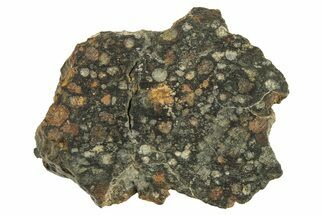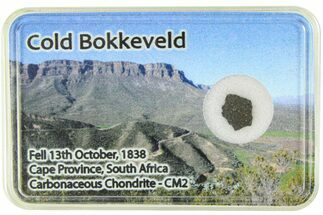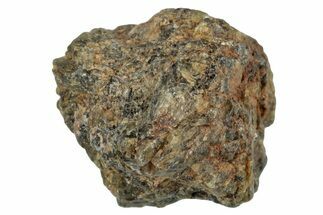.97" Chondrite Meteorite Section (6.46 g) - NWA 8160
This is a .97" wide (6.46 grams) cut section of the carbonaceous chondrite meteorite NWA 8160.
The NWA 8160 Meteorite
Two bags containing many small fragments of this meteorite were purchased from a Moroccan dealer at the Denver Gem and Mineral Show in 2013. Cutting revealed a classic CV (carbonaceous) chondrite texture, with many chondrules of various sizes and calcium aluminum inclusions (CAIs)--the first solids to crystallize out of the nebula during formation of our solar system! These inclusions also likely contain micro-diamonds that formed outside of and before our solar system. This may be some of the oldest meteoritic material ever known!
Meteoritical Bulletin Database Entry For NWA 8160
Two bags containing many small fragments of this meteorite were purchased from a Moroccan dealer at the Denver Gem and Mineral Show in 2013. Cutting revealed a classic CV (carbonaceous) chondrite texture, with many chondrules of various sizes and calcium aluminum inclusions (CAIs)--the first solids to crystallize out of the nebula during formation of our solar system! These inclusions also likely contain micro-diamonds that formed outside of and before our solar system. This may be some of the oldest meteoritic material ever known!
Meteoritical Bulletin Database Entry For NWA 8160
About Chondrites
A chondrite is a stony (non-metallic) meteorite that has not been modified by either melting or differentiation of the parent body. Chondrites are formed when various types of dust and small grains in the early Solar System accreted to form primitive asteroids. Some such bodies are captured in the planet’s gravity well and pulled to the surface. They are by far the most common type of meteorite, representing about 86 percent of all meteorites that have fallen to Earth.
Prominent among the components present in chondrites are the enigmatic chondrules, millimeter-sized spherical objects that originated as freely floating, molten or partially molten droplets in space; most chondrules are rich in the silicate minerals olivine and pyroxene. Chondrites also contain particles of various metals such as nickel, iron, and aluminum. These formed at the very beginning of the solar system and aggregated over time: they are the oldest rocks known on Earth!
Chondrites are divided into about fifteen distinct groups on the basis of their mineralogy, bulk chemical composition, and oxygen isotope compositions. The various chondrite groups likely originated on separate asteroids or groups of related asteroids. Each chondrite group has a distinctive mixture of chondrules, refractory inclusions, matrix (dust), characteristic chondrule sizes, and other components. Other ways of classifying chondrites include weathering and shock. The L chondrite group is the most common of these.
A chondrite is a stony (non-metallic) meteorite that has not been modified by either melting or differentiation of the parent body. Chondrites are formed when various types of dust and small grains in the early Solar System accreted to form primitive asteroids. Some such bodies are captured in the planet’s gravity well and pulled to the surface. They are by far the most common type of meteorite, representing about 86 percent of all meteorites that have fallen to Earth.
Prominent among the components present in chondrites are the enigmatic chondrules, millimeter-sized spherical objects that originated as freely floating, molten or partially molten droplets in space; most chondrules are rich in the silicate minerals olivine and pyroxene. Chondrites also contain particles of various metals such as nickel, iron, and aluminum. These formed at the very beginning of the solar system and aggregated over time: they are the oldest rocks known on Earth!
Chondrites are divided into about fifteen distinct groups on the basis of their mineralogy, bulk chemical composition, and oxygen isotope compositions. The various chondrite groups likely originated on separate asteroids or groups of related asteroids. Each chondrite group has a distinctive mixture of chondrules, refractory inclusions, matrix (dust), characteristic chondrule sizes, and other components. Other ways of classifying chondrites include weathering and shock. The L chondrite group is the most common of these.
TYPE
Carbonaceous Chondrite (CV3)
LOCATION
Morocco
SIZE
.97 x .87 x .36", 6.46 grams
CATEGORY
ITEM
#287886
 Reviews
Reviews









